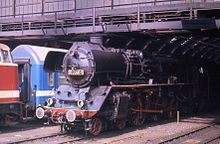Berlin Ostbahnhof
Template:Infobox Deutsche Bahn station Berlin Ostbahnhof (translates from German as Berlin East railway station) is a mainline railway station in Berlin, Germany. It is in Friedrichshain, now part of Friedrichshain-Kreuzberg district, and has undergone several name changes in its history. It was known as Berlin Hauptbahnhof from 1987 to 1998, a name now applied to Berlin's new central station. Alongside Berlin Zoologischer Garten station it was one of the city's two main stations; however, it has declined in significance since the opening of the new Hauptbahnhof on 26 May 2006, and many mainline trains have been re-routed through the new Tiergarten tunnels, bypassing Ostbahnhof.
History
Early history
The station opened in 1842 as Frankfurter Bahnhof as the terminus of the 100-km railway to Frankfurt (Oder). The first building was slightly north of its present location. In 1845, it was renamed Niederschlesisch-Märkischer Bahnhof (Lower Silesia-Brandenburg Station) after a railway merger. When the railways were taken over by the Prussian state in 1852, it was renamed Schlesischer Bahnhof (Silesian Station). It was rebuilt on the present site in 1882 when construction began on the Berlin Stadtbahn, the elevated railway through the city center built to link the city's major stations, completed in 1886. Two of the four tracks on the Stadtbahn later came to form one of the main routes of the Berlin S-Bahn suburban railway. The Ostbahnhof has never had a link to the Berlin U-Bahn subway, nor is one planned.
World War II and GDR

The station was severely damaged in the Second World War and completely rebuilt by the East German railway, the Deutsche Reichsbahn; in 1950 it was renamed Berlin Ostbahnhof, as Silesia was now largely in Poland.
Following the division of Germany, the station was, together with Berlin-Lichtenberg, one of two major railway stations in East Berlin. The wall ran only 200 m away from the station; today that part is the East Side Gallery, the longest remaining fragment of the Berlin Wall. In 1987 the postwar building was demolished and the station began to be rebuilt as East Berlin’s main station, grandly renamed Berlin Hauptbahnhof (Berlin Main Station). The plan called for a hotel and a large reception area for arriving Soviet bloc dignitaries. However, only part of the work was complete by the time of German reunification in 1990. A partially built staircase to the underground car park from this period in front of the station remains (in 2006) unfinished and fenced off. A partly constructed hotel was demolished in the early 1990s.

Recent years
The name Hauptbahnhof remained long after the division of Berlin ended, until 1998, when the station was re-renamed Berlin Ostbahnhof. One year later, work began to demolish the station and rebuild it once again, which was completed in 2002. Little remains of the 1980s structure except for an administrative block, some façade elements, and parts of the platform structure.
Characteristics
The station has 11 tracks and 9 platforms. 5 platforms are used for main line and 4 for S-Bahn. 2 tracks are through tracks.
Train services


S-Bahn, regional and long-distance services call at the station; though a number of Intercity-Express and Intercity services were lost to the newly opened Berlin Hauptbahnhof station further west, the Ostbahnhof still remains an important station for the eastern parts of Berlin
In popular culture
The Ostbahnhof was featured in the 2004 movie The Bourne Supremacy. In the film, Jason Bourne (Matt Damon) is seen parking his car here, entering the station and leaving a bag in a locker, and tracking down Pamela Landy (Joan Allen).
See also
- East Side Gallery
- Maria am Ostbahnhof
- Deutsche Bahn
- Sibirjak
- S-Bahn Berlin
- B.V.G.
- Berlin Wriezener Bahnhof
References
External links
![]() Media related to Berlin Ostbahnhof at Wikimedia Commons
Media related to Berlin Ostbahnhof at Wikimedia Commons
- Berlin Ostbahnhof information on the website of Deutsche Bahn
